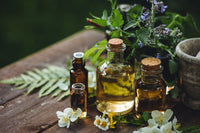Ever notice how your favorite candle seems to perform differently depending on the season? Or why that reed diffuser practically disappeared in winter but became almost overwhelming in summer? The science behind these observations is fascinating and practical for anyone looking to maintain consistent fragrance experiences year-round.
The Science of Scent Diffusion
Fragrance molecules need energy to become airborne and reach our noses. Temperature acts as the energy source, while humidity controls how these molecules travel through the air. Understanding this relationship helps explain why your home fragrances behave differently as conditions change.
Warm Weather Effects
Higher temperatures significantly amplify fragrance performance. When the mercury rises, scent molecules become more energetic, evaporating faster and traveling farther. This explains why that subtle candle you enjoyed in February might suddenly seem overwhelming in July.
During summer months, you'll likely need less fragrance to achieve the same effect. Consider:
- Burning candles for shorter periods
- Using fewer reed diffuser sticks
- Diluting room sprays slightly with distilled water
- Placing fragrance sources away from heat sources like sunny windows or electronics
Besides being economical, this prevents fragrance fatigue, the temporary condition where our noses become desensitized to scents we're constantly exposed to.
Cold Weather Challenges
Winter presents the opposite problem. Cooler air slows molecular movement, making fragrances seem weaker and less dynamic. The heating systems we use to combat cold weather further complicate matters by creating pockets of dry air throughout our homes.
To maintain fragrance impact during colder months:
- Position candles in areas with good air circulation but away from direct drafts
- Increase the number of reeds in diffusers
- Consider ultrasonic diffusers that physically propel fragrance into the air
- Rotate scents periodically to prevent fragrance fatigue
- Choose fragrances with stronger base notes that perform better in cool conditions
The Humidity Factor
Humidity levels dramatically affect how we perceive scents. High humidity (common in summer or in bathrooms) means the air already contains significant moisture, allowing fragrance molecules to travel efficiently. This explains why the same scent can seem more potent in a steamy bathroom than in a dry living room.
Conversely, very dry air, common in winter or in homes with forced-air heating, can suppress fragrance distribution. Maintaining optimal humidity levels (between 40-60%) with a humidifier can help fragrances perform consistently during dry seasons.
Strategic Seasonal Scenting
Rather than fighting against seasonal conditions, consider working with them by adjusting your fragrance selections:
For warmer months and humid environments:
- Lighter, fresher scents like citrus, light florals, and aquatics
- Less concentrated formulations
- Smaller fragrance sources
For cooler months and drier environments:
- Richer, denser scents with strong base notes like woods, amber, and spices
- Higher-concentration oils
- Larger or multiple fragrance sources
Storage Considerations
Temperature and humidity don't just affect how fragrances perform... they also impact how they age!
Extreme conditions can cause oils to break down prematurely, changing their scent profiles or reducing their effectiveness.
Store your fragrance products:
- Away from direct sunlight
- In temperature-stable environments (avoid attics, garages, or bathrooms)
- With caps and lids tightly secured to prevent evaporation
High-quality fragrance products are designed with some environmental resilience, but proper storage significantly extends their effective lifespan.
Finding Your Perfect Balance
Creating your ideal scent environment means being attentive to how your home's conditions fluctuate. The perfect fragrance experience comes from understanding these natural shifts and adjusting accordingly (sometimes using more product, sometimes less, and occasionally switching to scents better suited to current conditions.)
This mindful approach to home fragrance ensures you'll always get the experience you're looking for, regardless of what the thermometer or hygrometer might read.








